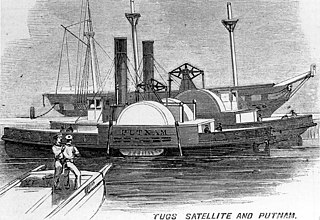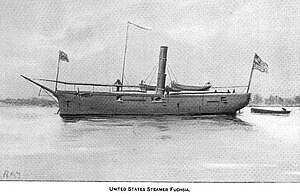
CSS Teaser had been the aging Georgetown, D.C. tugboat York River until the beginning of the American Civil War, when she was taken into the Confederate States Navy and took part in the famous Battle of Hampton Roads. Later, she was captured by the United States Navy and became the first USS Teaser.

The first USS Pocahontas, a screw steamer built at Medford, Massachusetts in 1852 as City of Boston, and purchased by the Navy at Boston, Massachusetts on 20 March 1855, was the first United States Navy ship to be named for Pocahontas, the Algonquian wife of Virginia colonist John Rolfe. She was originally commissioned as USS Despatch – the second U.S. Navy ship of that name – on 17 January 1856, with Lieutenant T. M. Crossan in command, and was recommissioned and renamed in 1860, seeing action in the American Civil War. As Pocahontas, one of her junior officers was Alfred Thayer Mahan, who would later achieve international fame as a military writer and theorist of naval power.

The first USS Mount Vernon was a wooden-screw steamer in the United States Navy.

USS Satellite was a large, steam-powered large tugboat, acquired by the Union Navy during the American Civil War and equipped with two powerful 8-inch guns. She was assigned to the Union blockade of the Confederate States of America.
USS Dai Ching was a steam gunboat in commissioned into service in the United States Navy in 1863. She served in the Union Navy during the American Civil War until her loss in 1865.
USS Heliotrope was a wooden steamer originally named Maggie Baker, which was acquired by the Union Navy for use during the American Civil War. In addition to patrol duty, Heliotrope performed other services, such as towing and dispatch running.

USS Jacob Bell was a sidewheel steamer acquired by the Union Navy for use during the American Civil War. She was one of the oldest vessels so acquired. Her duties included river patrols, guard duty, and other duties as assigned.
USS Anacostia was a steamer, constructed as a tugboat, that was first chartered by the United States Navy for service during the Paraguay crisis of the 1850s and then commissioned as a U.S. Navy ship. She later served prominently in the Union Navy during the American Civil War.

USS Young America was a Confederate steamer captured by the Union Navy’s blockade vessels, and subsequently placed in-service in the Union Navy during the American Civil War.
USS Zouave was a steamer acquired by the Union Navy during the American Civil War. She was needed by the Navy to be part of the fleet of ships to prevent blockade runners from entering ports in the Confederacy.

The first USS Resolute was a steamer acquired by the Union Navy during the American Civil War.

USS General Putnam – also known as the USS William G. Putnam – was acquired by the Union Navy during the first year of the American Civil War and outfitted as a gunboat and assigned to the Union blockade of the Confederate States of America. She also served as a tugboat and as a ship's tender when so required.
USS Morse was a ferryboat acquired by the Union Navy during the American Civil War.
USS Western World was a ship acquired by the Union Navy during the American Civil War. She was used by the Navy to patrol navigable waterways of the Confederacy to prevent the South from trading with other countries.
USS Tulip was a 183-ton steamer acquired by the Union Navy during the American Civil War.
USS Dan Smith was a schooner used by the Union Navy during the American Civil War. She was used by the Navy to patrol navigable waterways of the Confederacy to prevent the South from trading with other countries.

USS Thomas Freeborn was a steam tug acquired by the Union Navy during the American Civil War. She was used by the Navy as a gunboat to patrol navigable waterways of the Confederacy to prevent the South from trading with other countries.
USS Stepping Stones was a steamer purchased by the Union Navy during the early part of the American Civil War.

USS Polaris, originally called the America, was an 1864-screw steamer procured by the Union Navy as USS Periwinkle during the final months of the American Civil War. She served the Union Navy's struggle against the Confederate States as a gunboat.
USS Rescue was a small (111-ton) steamer commissioned by the United States Navy during the American Civil War.









